Analyzing Change Management: Change Agent Role & Lewin's Model
VerifiedAdded on 2023/06/15
|18
|4274
|468
Report
AI Summary
This report provides a comprehensive analysis of change management within organizations, focusing on the role of change agents and the application of Lewin's Change Model. It discusses the advantages of using external change agents, outlines five key activities for change agents (investigating, advocating, encouraging, advising, and managing), and explains the three stages of Lewin's model (Unfreeze, Transition, and Freeze). The report also highlights the importance of diagnosis and feedback in organizational change processes, using the Open System Model as a framework. It addresses potential challenges in implementing change, such as employee resistance and conflicting perceptions, and emphasizes the need for effective communication, training, and motivational strategies. The document is available on Desklib, a platform offering a range of study tools and solved assignments for students.
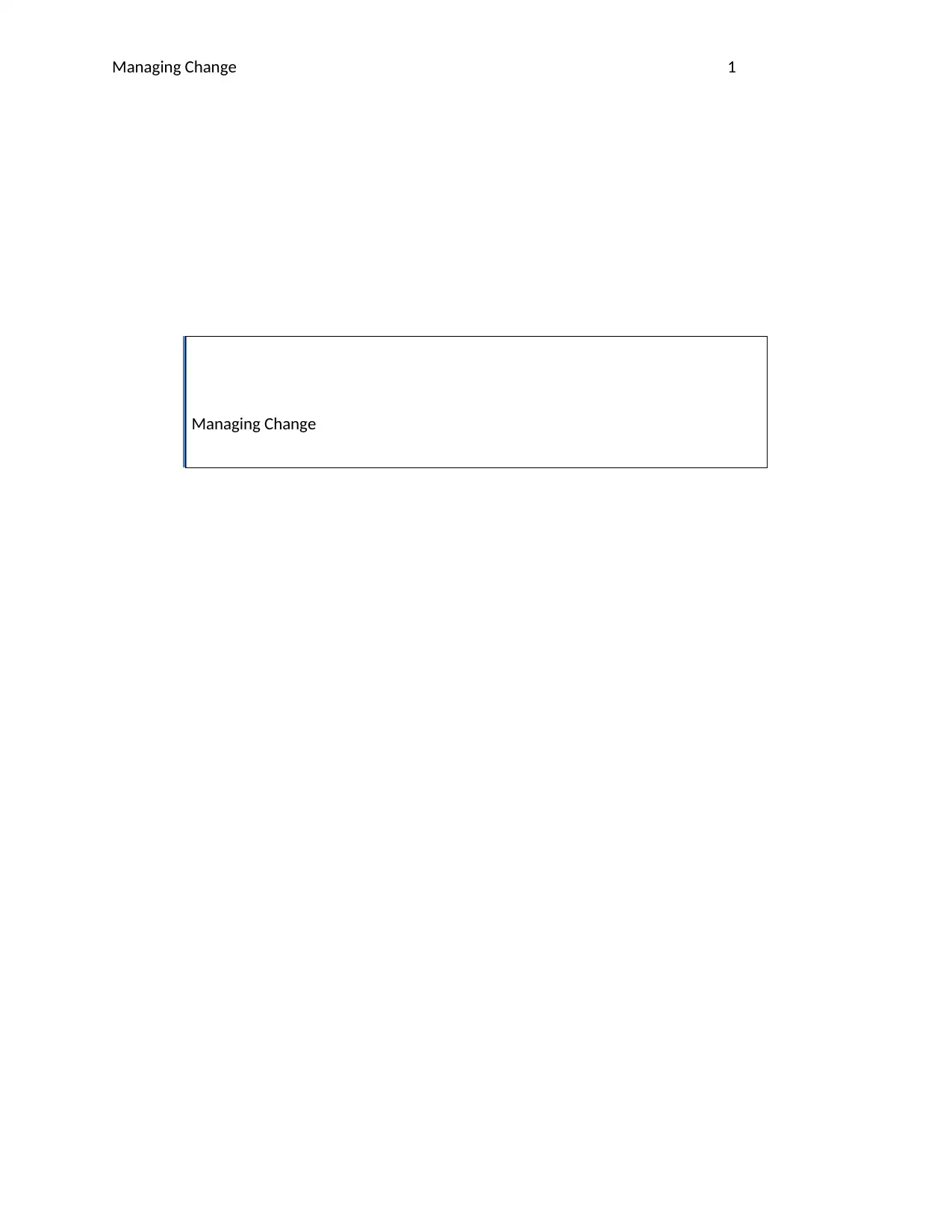
Managing Change 1
Managing Change
Managing Change
Paraphrase This Document
Need a fresh take? Get an instant paraphrase of this document with our AI Paraphraser
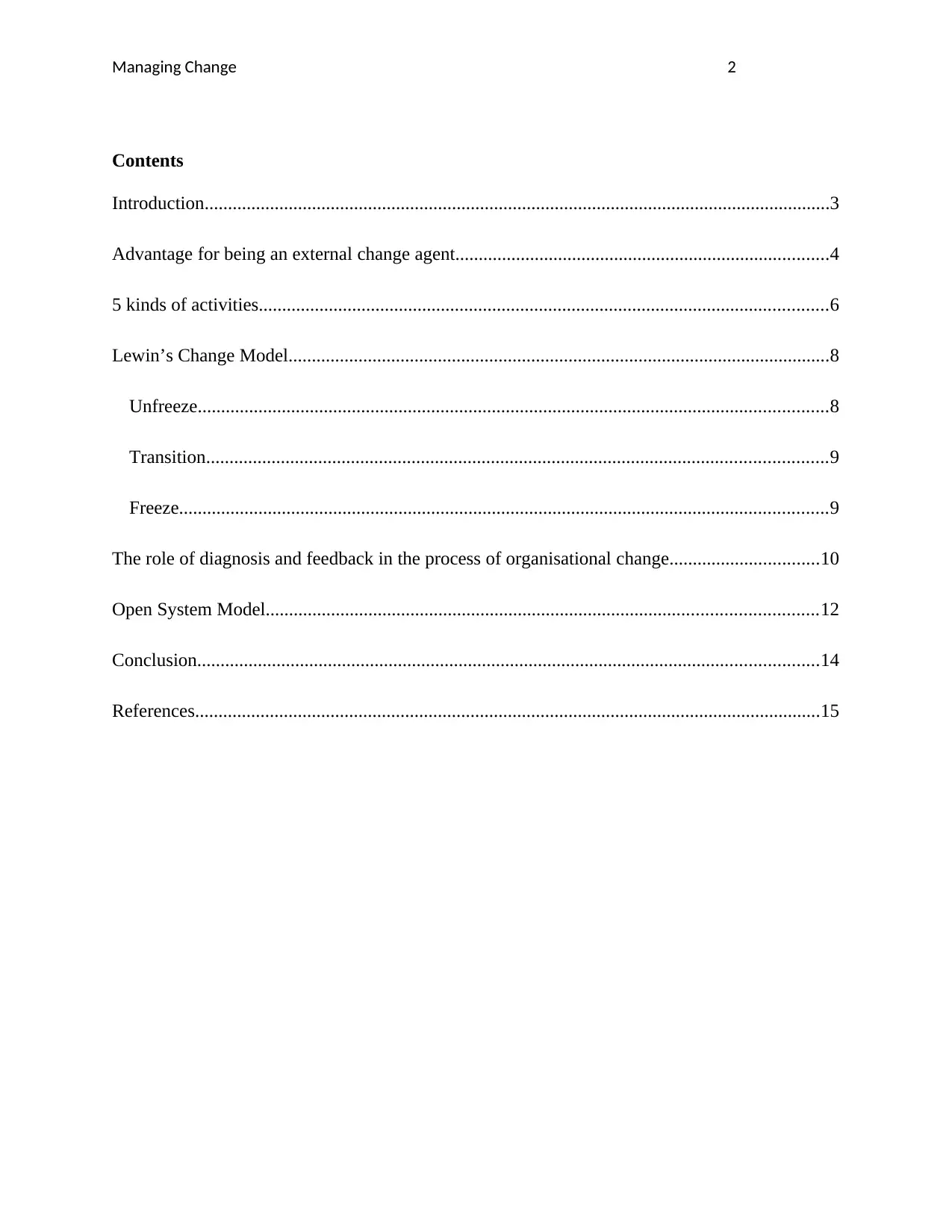
Managing Change 2
Contents
Introduction......................................................................................................................................3
Advantage for being an external change agent................................................................................4
5 kinds of activities..........................................................................................................................6
Lewin’s Change Model....................................................................................................................8
Unfreeze.......................................................................................................................................8
Transition.....................................................................................................................................9
Freeze...........................................................................................................................................9
The role of diagnosis and feedback in the process of organisational change................................10
Open System Model......................................................................................................................12
Conclusion.....................................................................................................................................14
References......................................................................................................................................15
Contents
Introduction......................................................................................................................................3
Advantage for being an external change agent................................................................................4
5 kinds of activities..........................................................................................................................6
Lewin’s Change Model....................................................................................................................8
Unfreeze.......................................................................................................................................8
Transition.....................................................................................................................................9
Freeze...........................................................................................................................................9
The role of diagnosis and feedback in the process of organisational change................................10
Open System Model......................................................................................................................12
Conclusion.....................................................................................................................................14
References......................................................................................................................................15
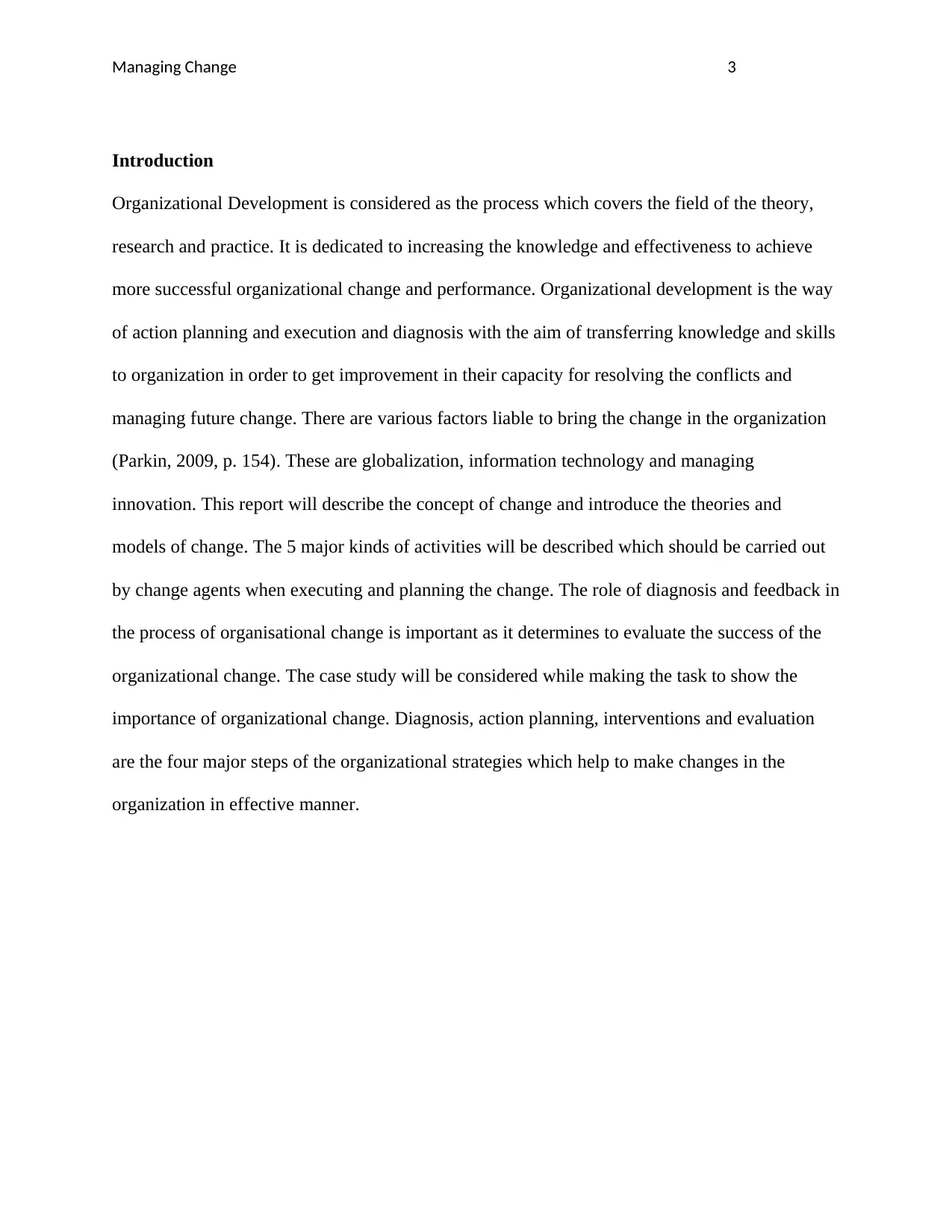
Managing Change 3
Introduction
Organizational Development is considered as the process which covers the field of the theory,
research and practice. It is dedicated to increasing the knowledge and effectiveness to achieve
more successful organizational change and performance. Organizational development is the way
of action planning and execution and diagnosis with the aim of transferring knowledge and skills
to organization in order to get improvement in their capacity for resolving the conflicts and
managing future change. There are various factors liable to bring the change in the organization
(Parkin, 2009, p. 154). These are globalization, information technology and managing
innovation. This report will describe the concept of change and introduce the theories and
models of change. The 5 major kinds of activities will be described which should be carried out
by change agents when executing and planning the change. The role of diagnosis and feedback in
the process of organisational change is important as it determines to evaluate the success of the
organizational change. The case study will be considered while making the task to show the
importance of organizational change. Diagnosis, action planning, interventions and evaluation
are the four major steps of the organizational strategies which help to make changes in the
organization in effective manner.
Introduction
Organizational Development is considered as the process which covers the field of the theory,
research and practice. It is dedicated to increasing the knowledge and effectiveness to achieve
more successful organizational change and performance. Organizational development is the way
of action planning and execution and diagnosis with the aim of transferring knowledge and skills
to organization in order to get improvement in their capacity for resolving the conflicts and
managing future change. There are various factors liable to bring the change in the organization
(Parkin, 2009, p. 154). These are globalization, information technology and managing
innovation. This report will describe the concept of change and introduce the theories and
models of change. The 5 major kinds of activities will be described which should be carried out
by change agents when executing and planning the change. The role of diagnosis and feedback in
the process of organisational change is important as it determines to evaluate the success of the
organizational change. The case study will be considered while making the task to show the
importance of organizational change. Diagnosis, action planning, interventions and evaluation
are the four major steps of the organizational strategies which help to make changes in the
organization in effective manner.
⊘ This is a preview!⊘
Do you want full access?
Subscribe today to unlock all pages.

Trusted by 1+ million students worldwide
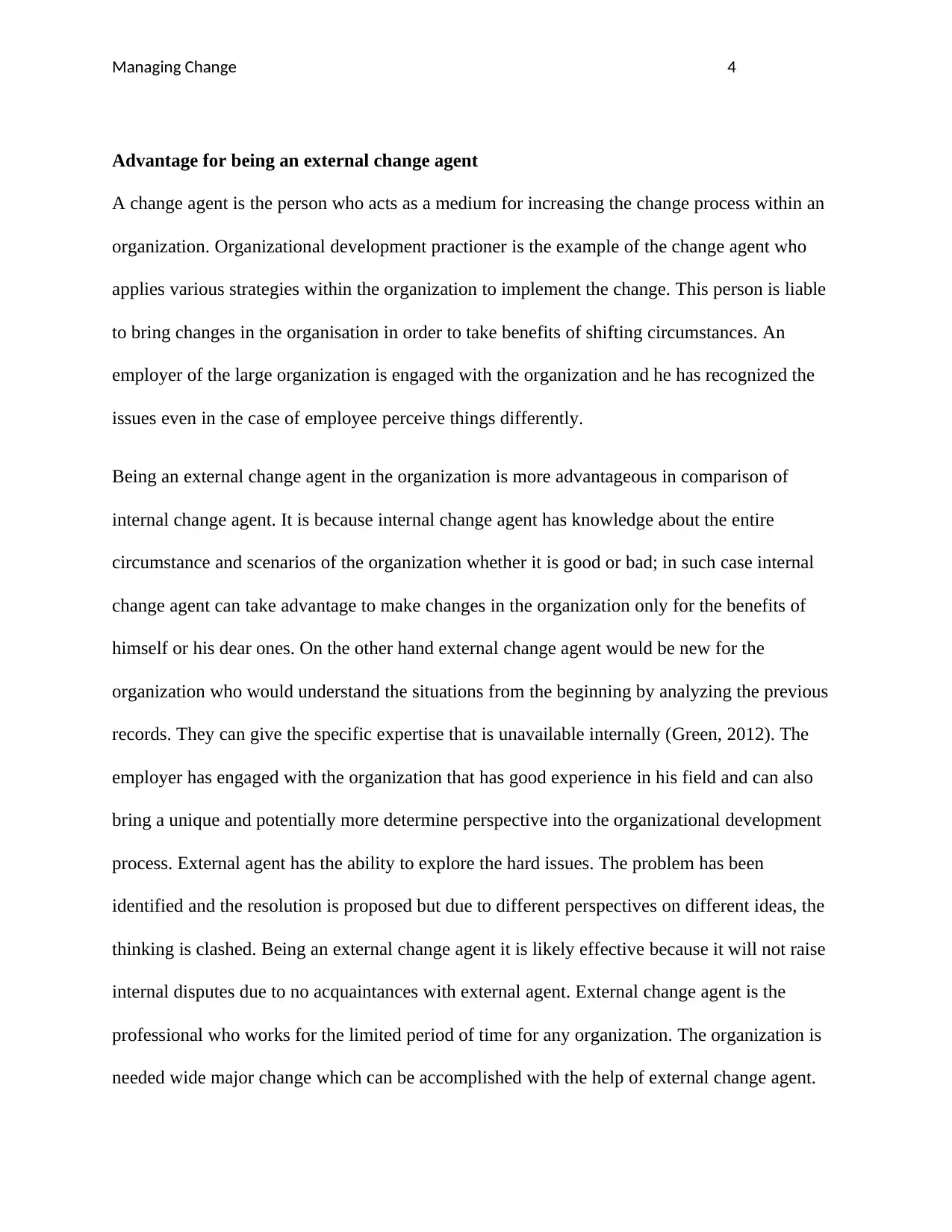
Managing Change 4
Advantage for being an external change agent
A change agent is the person who acts as a medium for increasing the change process within an
organization. Organizational development practioner is the example of the change agent who
applies various strategies within the organization to implement the change. This person is liable
to bring changes in the organisation in order to take benefits of shifting circumstances. An
employer of the large organization is engaged with the organization and he has recognized the
issues even in the case of employee perceive things differently.
Being an external change agent in the organization is more advantageous in comparison of
internal change agent. It is because internal change agent has knowledge about the entire
circumstance and scenarios of the organization whether it is good or bad; in such case internal
change agent can take advantage to make changes in the organization only for the benefits of
himself or his dear ones. On the other hand external change agent would be new for the
organization who would understand the situations from the beginning by analyzing the previous
records. They can give the specific expertise that is unavailable internally (Green, 2012). The
employer has engaged with the organization that has good experience in his field and can also
bring a unique and potentially more determine perspective into the organizational development
process. External agent has the ability to explore the hard issues. The problem has been
identified and the resolution is proposed but due to different perspectives on different ideas, the
thinking is clashed. Being an external change agent it is likely effective because it will not raise
internal disputes due to no acquaintances with external agent. External change agent is the
professional who works for the limited period of time for any organization. The organization is
needed wide major change which can be accomplished with the help of external change agent.
Advantage for being an external change agent
A change agent is the person who acts as a medium for increasing the change process within an
organization. Organizational development practioner is the example of the change agent who
applies various strategies within the organization to implement the change. This person is liable
to bring changes in the organisation in order to take benefits of shifting circumstances. An
employer of the large organization is engaged with the organization and he has recognized the
issues even in the case of employee perceive things differently.
Being an external change agent in the organization is more advantageous in comparison of
internal change agent. It is because internal change agent has knowledge about the entire
circumstance and scenarios of the organization whether it is good or bad; in such case internal
change agent can take advantage to make changes in the organization only for the benefits of
himself or his dear ones. On the other hand external change agent would be new for the
organization who would understand the situations from the beginning by analyzing the previous
records. They can give the specific expertise that is unavailable internally (Green, 2012). The
employer has engaged with the organization that has good experience in his field and can also
bring a unique and potentially more determine perspective into the organizational development
process. External agent has the ability to explore the hard issues. The problem has been
identified and the resolution is proposed but due to different perspectives on different ideas, the
thinking is clashed. Being an external change agent it is likely effective because it will not raise
internal disputes due to no acquaintances with external agent. External change agent is the
professional who works for the limited period of time for any organization. The organization is
needed wide major change which can be accomplished with the help of external change agent.
Paraphrase This Document
Need a fresh take? Get an instant paraphrase of this document with our AI Paraphraser
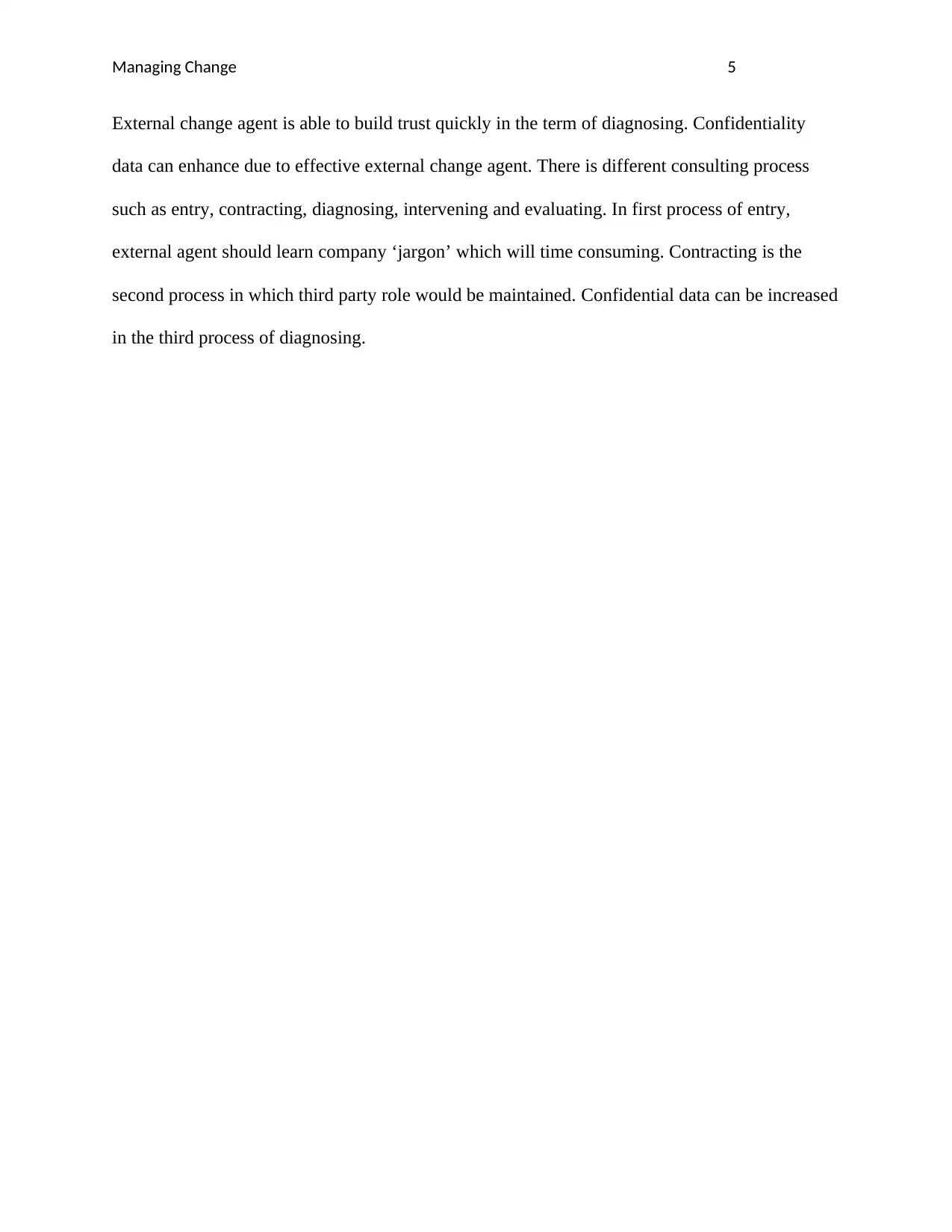
Managing Change 5
External change agent is able to build trust quickly in the term of diagnosing. Confidentiality
data can enhance due to effective external change agent. There is different consulting process
such as entry, contracting, diagnosing, intervening and evaluating. In first process of entry,
external agent should learn company ‘jargon’ which will time consuming. Contracting is the
second process in which third party role would be maintained. Confidential data can be increased
in the third process of diagnosing.
External change agent is able to build trust quickly in the term of diagnosing. Confidentiality
data can enhance due to effective external change agent. There is different consulting process
such as entry, contracting, diagnosing, intervening and evaluating. In first process of entry,
external agent should learn company ‘jargon’ which will time consuming. Contracting is the
second process in which third party role would be maintained. Confidential data can be increased
in the third process of diagnosing.
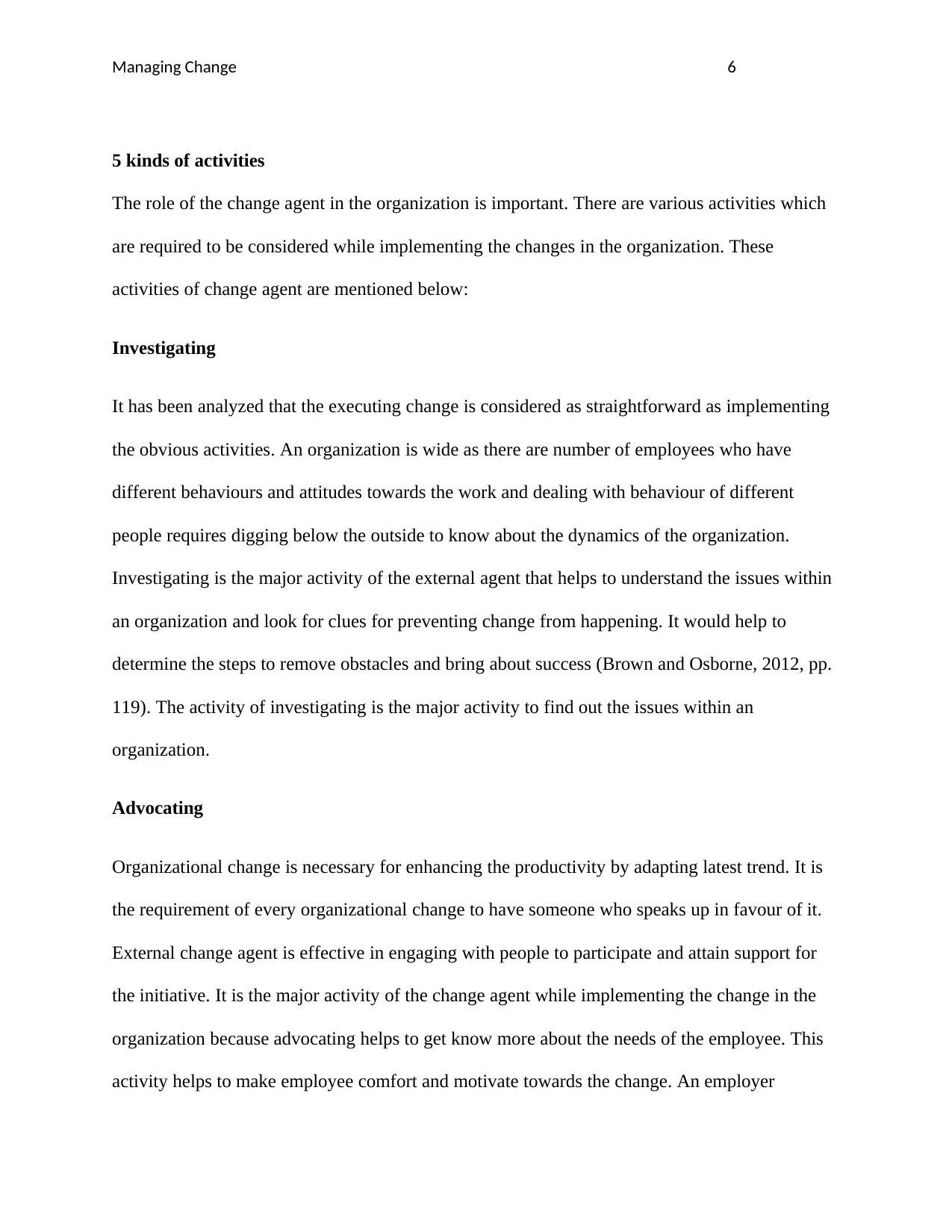
Managing Change 6
5 kinds of activities
The role of the change agent in the organization is important. There are various activities which
are required to be considered while implementing the changes in the organization. These
activities of change agent are mentioned below:
Investigating
It has been analyzed that the executing change is considered as straightforward as implementing
the obvious activities. An organization is wide as there are number of employees who have
different behaviours and attitudes towards the work and dealing with behaviour of different
people requires digging below the outside to know about the dynamics of the organization.
Investigating is the major activity of the external agent that helps to understand the issues within
an organization and look for clues for preventing change from happening. It would help to
determine the steps to remove obstacles and bring about success (Brown and Osborne, 2012, pp.
119). The activity of investigating is the major activity to find out the issues within an
organization.
Advocating
Organizational change is necessary for enhancing the productivity by adapting latest trend. It is
the requirement of every organizational change to have someone who speaks up in favour of it.
External change agent is effective in engaging with people to participate and attain support for
the initiative. It is the major activity of the change agent while implementing the change in the
organization because advocating helps to get know more about the needs of the employee. This
activity helps to make employee comfort and motivate towards the change. An employer
5 kinds of activities
The role of the change agent in the organization is important. There are various activities which
are required to be considered while implementing the changes in the organization. These
activities of change agent are mentioned below:
Investigating
It has been analyzed that the executing change is considered as straightforward as implementing
the obvious activities. An organization is wide as there are number of employees who have
different behaviours and attitudes towards the work and dealing with behaviour of different
people requires digging below the outside to know about the dynamics of the organization.
Investigating is the major activity of the external agent that helps to understand the issues within
an organization and look for clues for preventing change from happening. It would help to
determine the steps to remove obstacles and bring about success (Brown and Osborne, 2012, pp.
119). The activity of investigating is the major activity to find out the issues within an
organization.
Advocating
Organizational change is necessary for enhancing the productivity by adapting latest trend. It is
the requirement of every organizational change to have someone who speaks up in favour of it.
External change agent is effective in engaging with people to participate and attain support for
the initiative. It is the major activity of the change agent while implementing the change in the
organization because advocating helps to get know more about the needs of the employee. This
activity helps to make employee comfort and motivate towards the change. An employer
⊘ This is a preview!⊘
Do you want full access?
Subscribe today to unlock all pages.

Trusted by 1+ million students worldwide
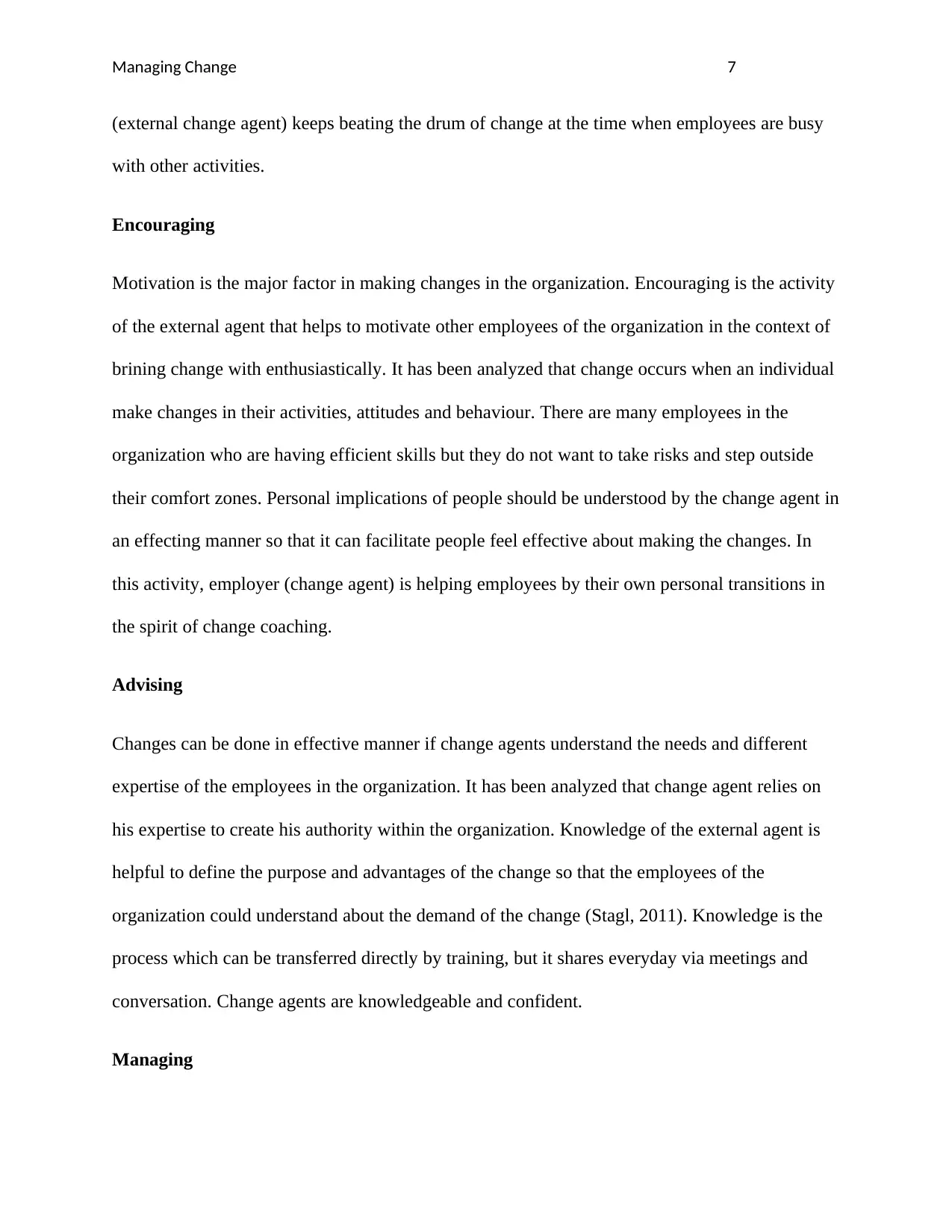
Managing Change 7
(external change agent) keeps beating the drum of change at the time when employees are busy
with other activities.
Encouraging
Motivation is the major factor in making changes in the organization. Encouraging is the activity
of the external agent that helps to motivate other employees of the organization in the context of
brining change with enthusiastically. It has been analyzed that change occurs when an individual
make changes in their activities, attitudes and behaviour. There are many employees in the
organization who are having efficient skills but they do not want to take risks and step outside
their comfort zones. Personal implications of people should be understood by the change agent in
an effecting manner so that it can facilitate people feel effective about making the changes. In
this activity, employer (change agent) is helping employees by their own personal transitions in
the spirit of change coaching.
Advising
Changes can be done in effective manner if change agents understand the needs and different
expertise of the employees in the organization. It has been analyzed that change agent relies on
his expertise to create his authority within the organization. Knowledge of the external agent is
helpful to define the purpose and advantages of the change so that the employees of the
organization could understand about the demand of the change (Stagl, 2011). Knowledge is the
process which can be transferred directly by training, but it shares everyday via meetings and
conversation. Change agents are knowledgeable and confident.
Managing
(external change agent) keeps beating the drum of change at the time when employees are busy
with other activities.
Encouraging
Motivation is the major factor in making changes in the organization. Encouraging is the activity
of the external agent that helps to motivate other employees of the organization in the context of
brining change with enthusiastically. It has been analyzed that change occurs when an individual
make changes in their activities, attitudes and behaviour. There are many employees in the
organization who are having efficient skills but they do not want to take risks and step outside
their comfort zones. Personal implications of people should be understood by the change agent in
an effecting manner so that it can facilitate people feel effective about making the changes. In
this activity, employer (change agent) is helping employees by their own personal transitions in
the spirit of change coaching.
Advising
Changes can be done in effective manner if change agents understand the needs and different
expertise of the employees in the organization. It has been analyzed that change agent relies on
his expertise to create his authority within the organization. Knowledge of the external agent is
helpful to define the purpose and advantages of the change so that the employees of the
organization could understand about the demand of the change (Stagl, 2011). Knowledge is the
process which can be transferred directly by training, but it shares everyday via meetings and
conversation. Change agents are knowledgeable and confident.
Managing
Paraphrase This Document
Need a fresh take? Get an instant paraphrase of this document with our AI Paraphraser
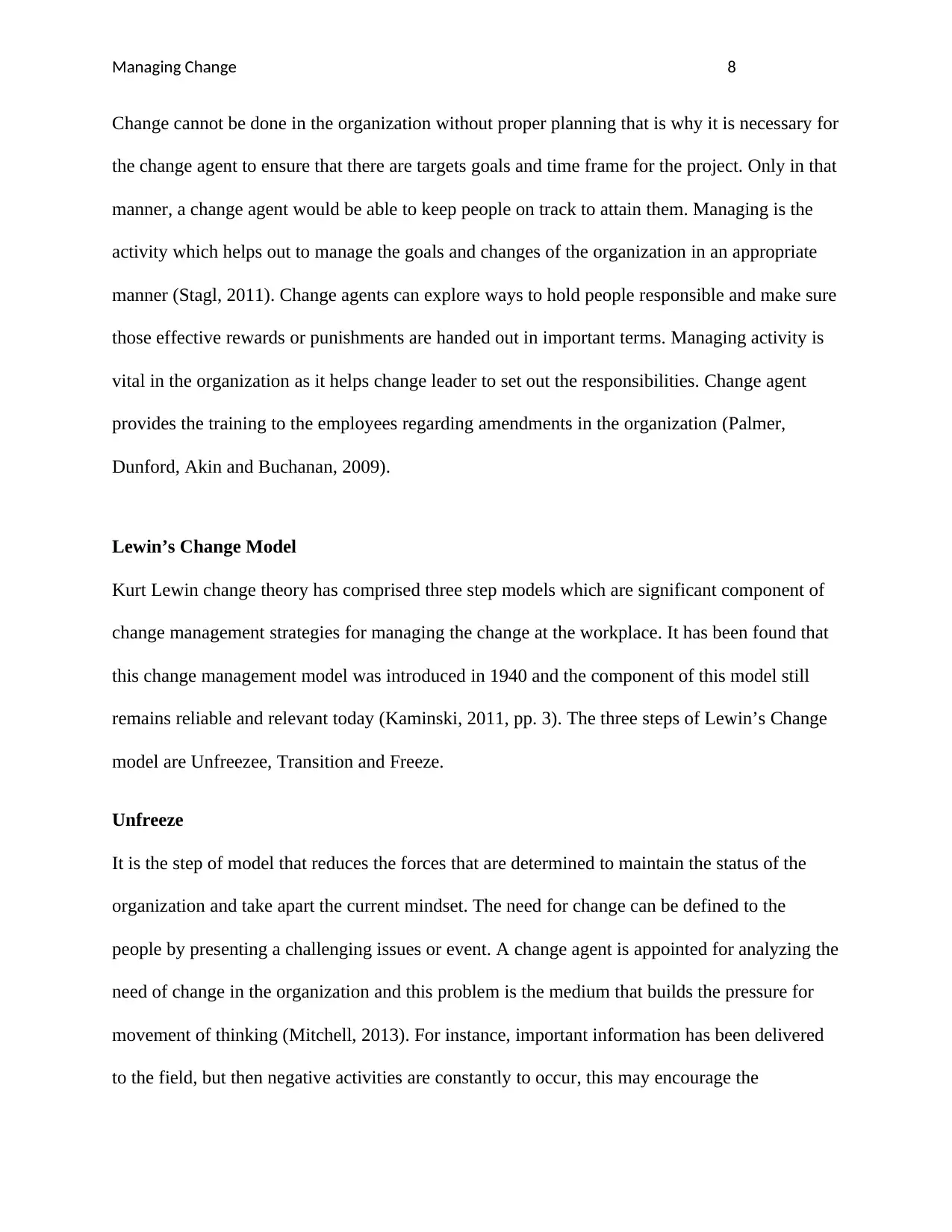
Managing Change 8
Change cannot be done in the organization without proper planning that is why it is necessary for
the change agent to ensure that there are targets goals and time frame for the project. Only in that
manner, a change agent would be able to keep people on track to attain them. Managing is the
activity which helps out to manage the goals and changes of the organization in an appropriate
manner (Stagl, 2011). Change agents can explore ways to hold people responsible and make sure
those effective rewards or punishments are handed out in important terms. Managing activity is
vital in the organization as it helps change leader to set out the responsibilities. Change agent
provides the training to the employees regarding amendments in the organization (Palmer,
Dunford, Akin and Buchanan, 2009).
Lewin’s Change Model
Kurt Lewin change theory has comprised three step models which are significant component of
change management strategies for managing the change at the workplace. It has been found that
this change management model was introduced in 1940 and the component of this model still
remains reliable and relevant today (Kaminski, 2011, pp. 3). The three steps of Lewin’s Change
model are Unfreezee, Transition and Freeze.
Unfreeze
It is the step of model that reduces the forces that are determined to maintain the status of the
organization and take apart the current mindset. The need for change can be defined to the
people by presenting a challenging issues or event. A change agent is appointed for analyzing the
need of change in the organization and this problem is the medium that builds the pressure for
movement of thinking (Mitchell, 2013). For instance, important information has been delivered
to the field, but then negative activities are constantly to occur, this may encourage the
Change cannot be done in the organization without proper planning that is why it is necessary for
the change agent to ensure that there are targets goals and time frame for the project. Only in that
manner, a change agent would be able to keep people on track to attain them. Managing is the
activity which helps out to manage the goals and changes of the organization in an appropriate
manner (Stagl, 2011). Change agents can explore ways to hold people responsible and make sure
those effective rewards or punishments are handed out in important terms. Managing activity is
vital in the organization as it helps change leader to set out the responsibilities. Change agent
provides the training to the employees regarding amendments in the organization (Palmer,
Dunford, Akin and Buchanan, 2009).
Lewin’s Change Model
Kurt Lewin change theory has comprised three step models which are significant component of
change management strategies for managing the change at the workplace. It has been found that
this change management model was introduced in 1940 and the component of this model still
remains reliable and relevant today (Kaminski, 2011, pp. 3). The three steps of Lewin’s Change
model are Unfreezee, Transition and Freeze.
Unfreeze
It is the step of model that reduces the forces that are determined to maintain the status of the
organization and take apart the current mindset. The need for change can be defined to the
people by presenting a challenging issues or event. A change agent is appointed for analyzing the
need of change in the organization and this problem is the medium that builds the pressure for
movement of thinking (Mitchell, 2013). For instance, important information has been delivered
to the field, but then negative activities are constantly to occur, this may encourage the
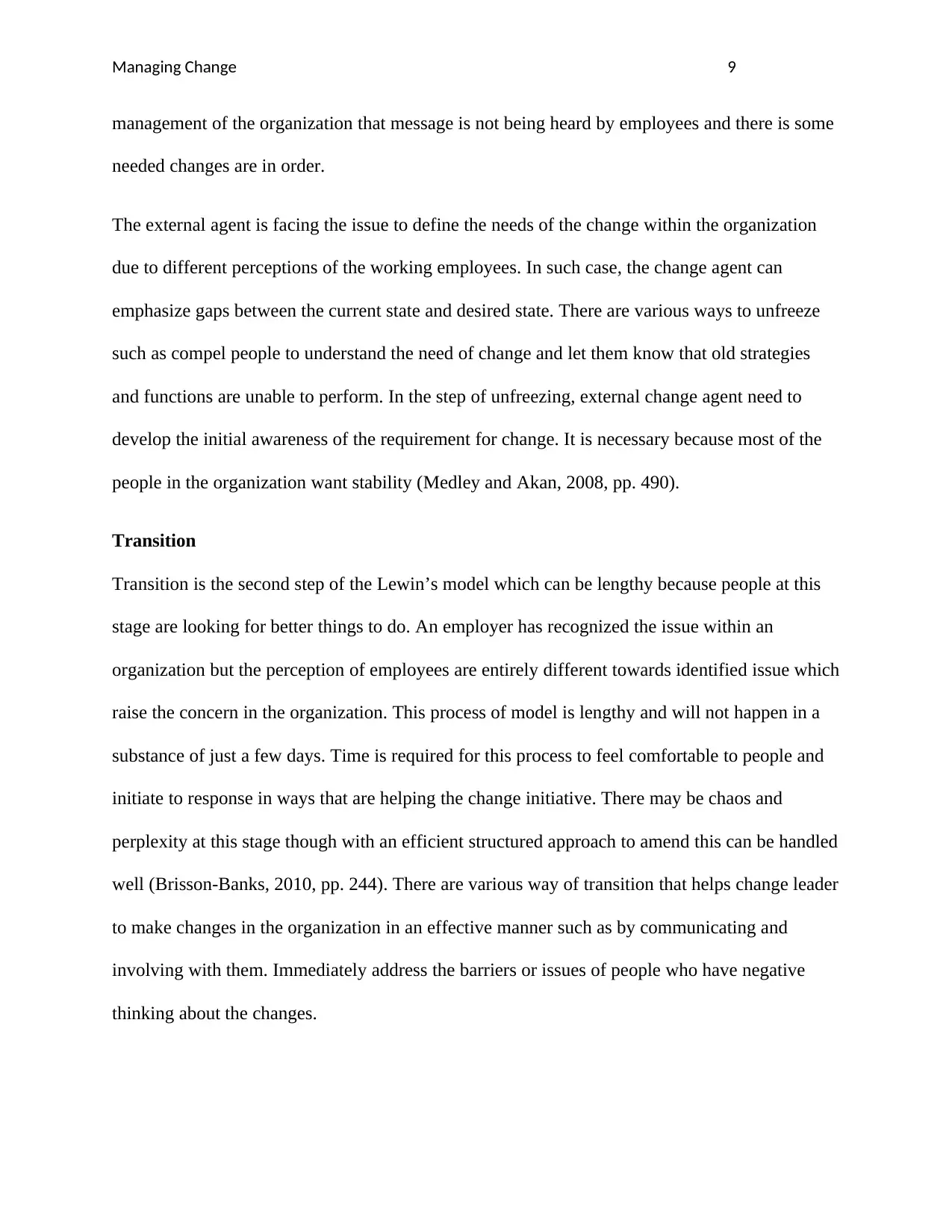
Managing Change 9
management of the organization that message is not being heard by employees and there is some
needed changes are in order.
The external agent is facing the issue to define the needs of the change within the organization
due to different perceptions of the working employees. In such case, the change agent can
emphasize gaps between the current state and desired state. There are various ways to unfreeze
such as compel people to understand the need of change and let them know that old strategies
and functions are unable to perform. In the step of unfreezing, external change agent need to
develop the initial awareness of the requirement for change. It is necessary because most of the
people in the organization want stability (Medley and Akan, 2008, pp. 490).
Transition
Transition is the second step of the Lewin’s model which can be lengthy because people at this
stage are looking for better things to do. An employer has recognized the issue within an
organization but the perception of employees are entirely different towards identified issue which
raise the concern in the organization. This process of model is lengthy and will not happen in a
substance of just a few days. Time is required for this process to feel comfortable to people and
initiate to response in ways that are helping the change initiative. There may be chaos and
perplexity at this stage though with an efficient structured approach to amend this can be handled
well (Brisson-Banks, 2010, pp. 244). There are various way of transition that helps change leader
to make changes in the organization in an effective manner such as by communicating and
involving with them. Immediately address the barriers or issues of people who have negative
thinking about the changes.
management of the organization that message is not being heard by employees and there is some
needed changes are in order.
The external agent is facing the issue to define the needs of the change within the organization
due to different perceptions of the working employees. In such case, the change agent can
emphasize gaps between the current state and desired state. There are various ways to unfreeze
such as compel people to understand the need of change and let them know that old strategies
and functions are unable to perform. In the step of unfreezing, external change agent need to
develop the initial awareness of the requirement for change. It is necessary because most of the
people in the organization want stability (Medley and Akan, 2008, pp. 490).
Transition
Transition is the second step of the Lewin’s model which can be lengthy because people at this
stage are looking for better things to do. An employer has recognized the issue within an
organization but the perception of employees are entirely different towards identified issue which
raise the concern in the organization. This process of model is lengthy and will not happen in a
substance of just a few days. Time is required for this process to feel comfortable to people and
initiate to response in ways that are helping the change initiative. There may be chaos and
perplexity at this stage though with an efficient structured approach to amend this can be handled
well (Brisson-Banks, 2010, pp. 244). There are various way of transition that helps change leader
to make changes in the organization in an effective manner such as by communicating and
involving with them. Immediately address the barriers or issues of people who have negative
thinking about the changes.
⊘ This is a preview!⊘
Do you want full access?
Subscribe today to unlock all pages.

Trusted by 1+ million students worldwide
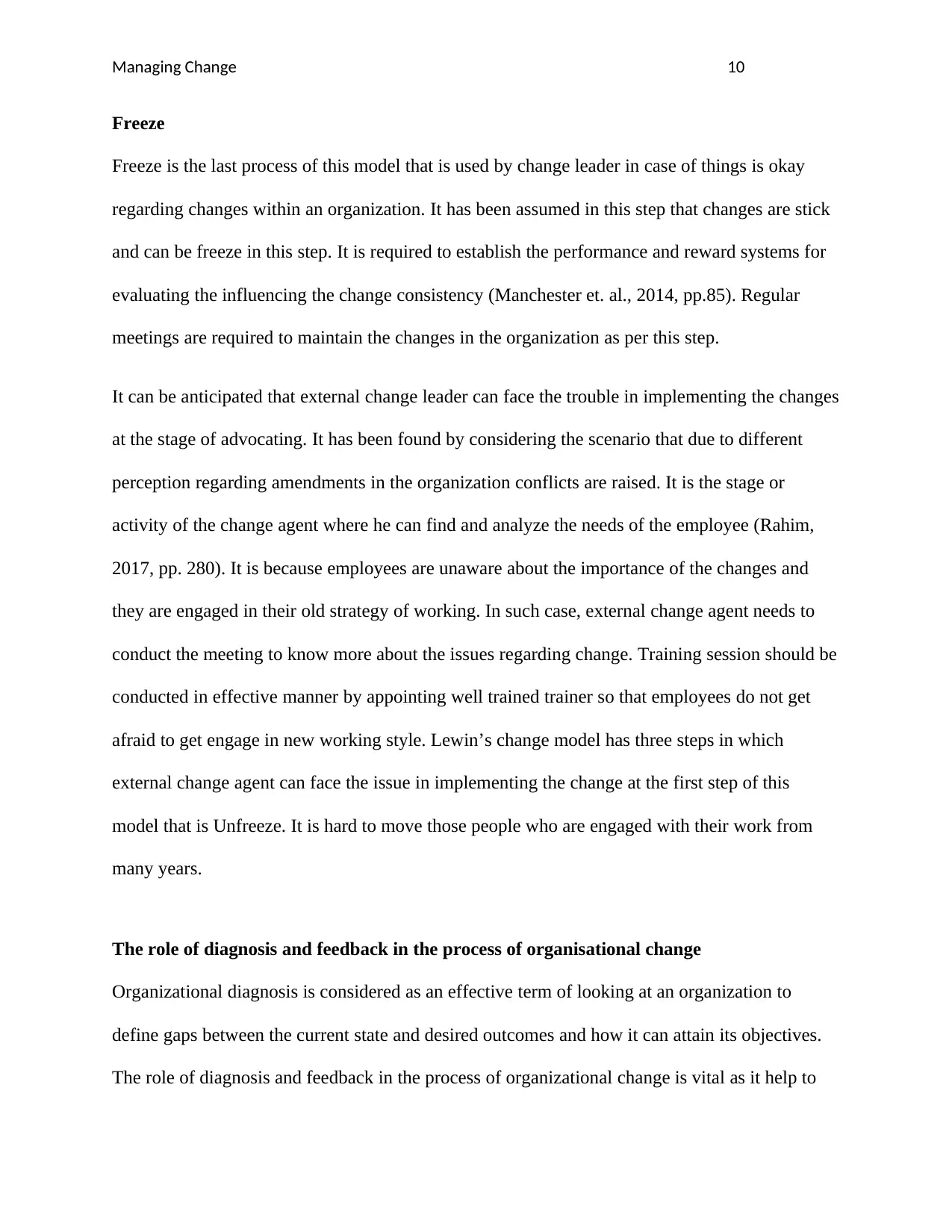
Managing Change 10
Freeze
Freeze is the last process of this model that is used by change leader in case of things is okay
regarding changes within an organization. It has been assumed in this step that changes are stick
and can be freeze in this step. It is required to establish the performance and reward systems for
evaluating the influencing the change consistency (Manchester et. al., 2014, pp.85). Regular
meetings are required to maintain the changes in the organization as per this step.
It can be anticipated that external change leader can face the trouble in implementing the changes
at the stage of advocating. It has been found by considering the scenario that due to different
perception regarding amendments in the organization conflicts are raised. It is the stage or
activity of the change agent where he can find and analyze the needs of the employee (Rahim,
2017, pp. 280). It is because employees are unaware about the importance of the changes and
they are engaged in their old strategy of working. In such case, external change agent needs to
conduct the meeting to know more about the issues regarding change. Training session should be
conducted in effective manner by appointing well trained trainer so that employees do not get
afraid to get engage in new working style. Lewin’s change model has three steps in which
external change agent can face the issue in implementing the change at the first step of this
model that is Unfreeze. It is hard to move those people who are engaged with their work from
many years.
The role of diagnosis and feedback in the process of organisational change
Organizational diagnosis is considered as an effective term of looking at an organization to
define gaps between the current state and desired outcomes and how it can attain its objectives.
The role of diagnosis and feedback in the process of organizational change is vital as it help to
Freeze
Freeze is the last process of this model that is used by change leader in case of things is okay
regarding changes within an organization. It has been assumed in this step that changes are stick
and can be freeze in this step. It is required to establish the performance and reward systems for
evaluating the influencing the change consistency (Manchester et. al., 2014, pp.85). Regular
meetings are required to maintain the changes in the organization as per this step.
It can be anticipated that external change leader can face the trouble in implementing the changes
at the stage of advocating. It has been found by considering the scenario that due to different
perception regarding amendments in the organization conflicts are raised. It is the stage or
activity of the change agent where he can find and analyze the needs of the employee (Rahim,
2017, pp. 280). It is because employees are unaware about the importance of the changes and
they are engaged in their old strategy of working. In such case, external change agent needs to
conduct the meeting to know more about the issues regarding change. Training session should be
conducted in effective manner by appointing well trained trainer so that employees do not get
afraid to get engage in new working style. Lewin’s change model has three steps in which
external change agent can face the issue in implementing the change at the first step of this
model that is Unfreeze. It is hard to move those people who are engaged with their work from
many years.
The role of diagnosis and feedback in the process of organisational change
Organizational diagnosis is considered as an effective term of looking at an organization to
define gaps between the current state and desired outcomes and how it can attain its objectives.
The role of diagnosis and feedback in the process of organizational change is vital as it help to
Paraphrase This Document
Need a fresh take? Get an instant paraphrase of this document with our AI Paraphraser
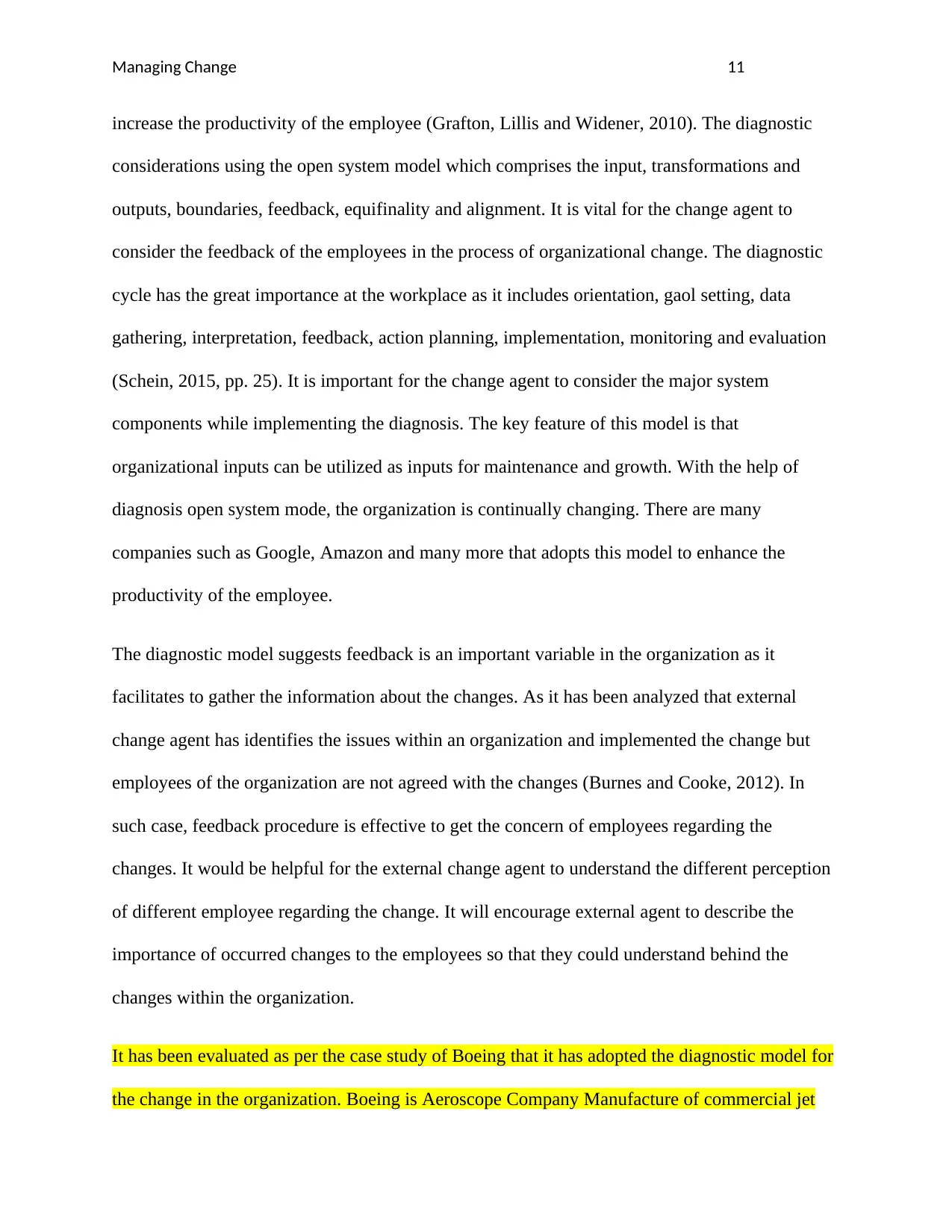
Managing Change 11
increase the productivity of the employee (Grafton, Lillis and Widener, 2010). The diagnostic
considerations using the open system model which comprises the input, transformations and
outputs, boundaries, feedback, equifinality and alignment. It is vital for the change agent to
consider the feedback of the employees in the process of organizational change. The diagnostic
cycle has the great importance at the workplace as it includes orientation, gaol setting, data
gathering, interpretation, feedback, action planning, implementation, monitoring and evaluation
(Schein, 2015, pp. 25). It is important for the change agent to consider the major system
components while implementing the diagnosis. The key feature of this model is that
organizational inputs can be utilized as inputs for maintenance and growth. With the help of
diagnosis open system mode, the organization is continually changing. There are many
companies such as Google, Amazon and many more that adopts this model to enhance the
productivity of the employee.
The diagnostic model suggests feedback is an important variable in the organization as it
facilitates to gather the information about the changes. As it has been analyzed that external
change agent has identifies the issues within an organization and implemented the change but
employees of the organization are not agreed with the changes (Burnes and Cooke, 2012). In
such case, feedback procedure is effective to get the concern of employees regarding the
changes. It would be helpful for the external change agent to understand the different perception
of different employee regarding the change. It will encourage external agent to describe the
importance of occurred changes to the employees so that they could understand behind the
changes within the organization.
It has been evaluated as per the case study of Boeing that it has adopted the diagnostic model for
the change in the organization. Boeing is Aeroscope Company Manufacture of commercial jet
increase the productivity of the employee (Grafton, Lillis and Widener, 2010). The diagnostic
considerations using the open system model which comprises the input, transformations and
outputs, boundaries, feedback, equifinality and alignment. It is vital for the change agent to
consider the feedback of the employees in the process of organizational change. The diagnostic
cycle has the great importance at the workplace as it includes orientation, gaol setting, data
gathering, interpretation, feedback, action planning, implementation, monitoring and evaluation
(Schein, 2015, pp. 25). It is important for the change agent to consider the major system
components while implementing the diagnosis. The key feature of this model is that
organizational inputs can be utilized as inputs for maintenance and growth. With the help of
diagnosis open system mode, the organization is continually changing. There are many
companies such as Google, Amazon and many more that adopts this model to enhance the
productivity of the employee.
The diagnostic model suggests feedback is an important variable in the organization as it
facilitates to gather the information about the changes. As it has been analyzed that external
change agent has identifies the issues within an organization and implemented the change but
employees of the organization are not agreed with the changes (Burnes and Cooke, 2012). In
such case, feedback procedure is effective to get the concern of employees regarding the
changes. It would be helpful for the external change agent to understand the different perception
of different employee regarding the change. It will encourage external agent to describe the
importance of occurred changes to the employees so that they could understand behind the
changes within the organization.
It has been evaluated as per the case study of Boeing that it has adopted the diagnostic model for
the change in the organization. Boeing is Aeroscope Company Manufacture of commercial jet
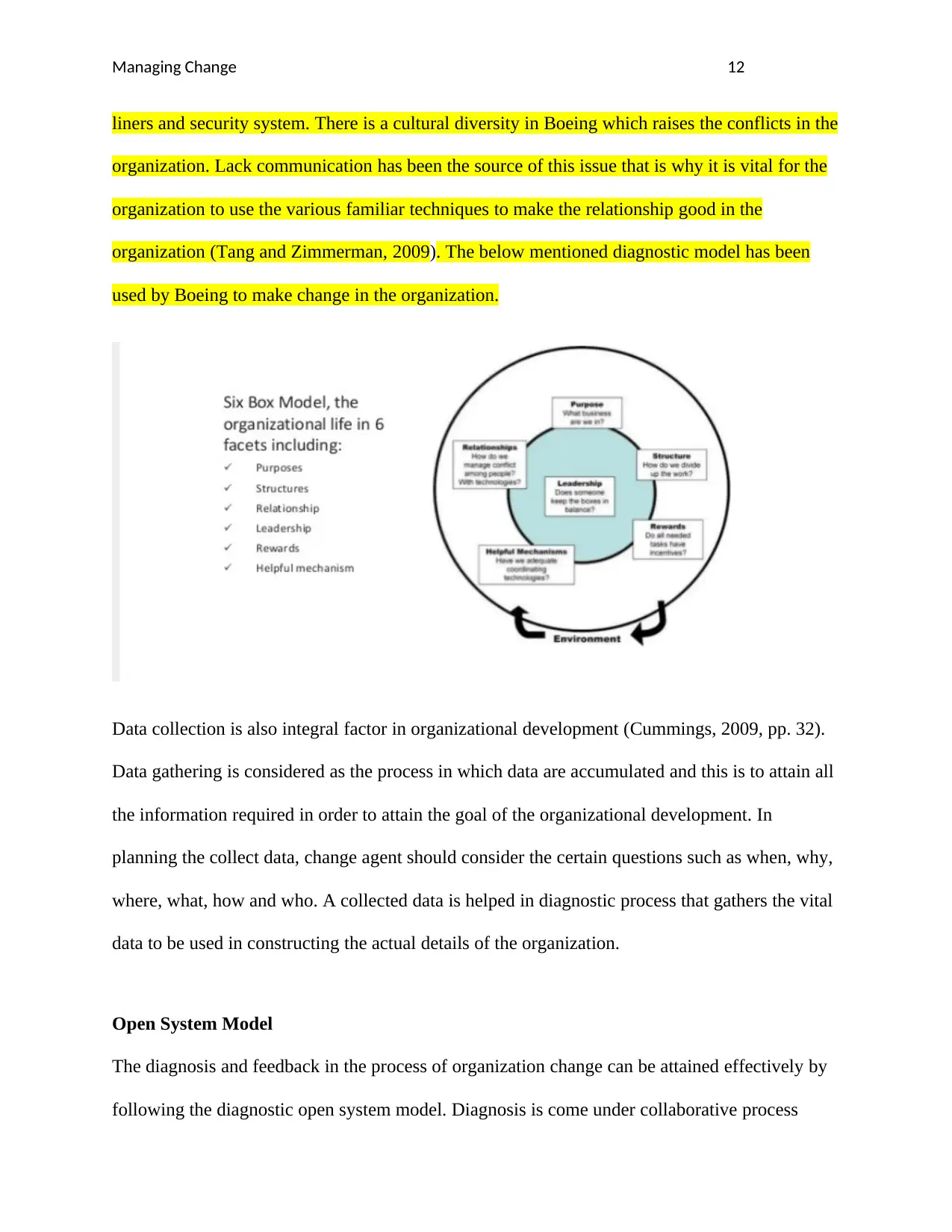
Managing Change 12
liners and security system. There is a cultural diversity in Boeing which raises the conflicts in the
organization. Lack communication has been the source of this issue that is why it is vital for the
organization to use the various familiar techniques to make the relationship good in the
organization (Tang and Zimmerman, 2009). The below mentioned diagnostic model has been
used by Boeing to make change in the organization.
Data collection is also integral factor in organizational development (Cummings, 2009, pp. 32).
Data gathering is considered as the process in which data are accumulated and this is to attain all
the information required in order to attain the goal of the organizational development. In
planning the collect data, change agent should consider the certain questions such as when, why,
where, what, how and who. A collected data is helped in diagnostic process that gathers the vital
data to be used in constructing the actual details of the organization.
Open System Model
The diagnosis and feedback in the process of organization change can be attained effectively by
following the diagnostic open system model. Diagnosis is come under collaborative process
liners and security system. There is a cultural diversity in Boeing which raises the conflicts in the
organization. Lack communication has been the source of this issue that is why it is vital for the
organization to use the various familiar techniques to make the relationship good in the
organization (Tang and Zimmerman, 2009). The below mentioned diagnostic model has been
used by Boeing to make change in the organization.
Data collection is also integral factor in organizational development (Cummings, 2009, pp. 32).
Data gathering is considered as the process in which data are accumulated and this is to attain all
the information required in order to attain the goal of the organizational development. In
planning the collect data, change agent should consider the certain questions such as when, why,
where, what, how and who. A collected data is helped in diagnostic process that gathers the vital
data to be used in constructing the actual details of the organization.
Open System Model
The diagnosis and feedback in the process of organization change can be attained effectively by
following the diagnostic open system model. Diagnosis is come under collaborative process
⊘ This is a preview!⊘
Do you want full access?
Subscribe today to unlock all pages.

Trusted by 1+ million students worldwide
1 out of 18
Related Documents
Your All-in-One AI-Powered Toolkit for Academic Success.
+13062052269
info@desklib.com
Available 24*7 on WhatsApp / Email
![[object Object]](/_next/static/media/star-bottom.7253800d.svg)
Unlock your academic potential
Copyright © 2020–2025 A2Z Services. All Rights Reserved. Developed and managed by ZUCOL.





